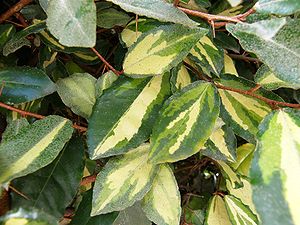Thorny olive willow
| Thorny olive willow | ||||||||||||
|---|---|---|---|---|---|---|---|---|---|---|---|---|

Thorny olive willow ( Elaeagnus pungens 'Maculata'), this variegated variety is also called yellow olive willow. |
||||||||||||
| Systematics | ||||||||||||
|
||||||||||||
| Scientific name | ||||||||||||
| Elaeagnus pungens | ||||||||||||
| Thunb. |
The thorny olive willow ( Elaeagnus pungens ), also called Stech-Ölweide , is a plant species from the genus of the olive willow ( Elaeagnus ) within the family of the olive plants (Elaeagnaceae).
description
Vegetative characteristics
The thorny olive grows as an evergreen, well-branched, slow-growing, mostly thorny shrub that reaches heights of 3 to 4 meters. This shrub is sufficiently hardy in Central Europe. The bark of young twigs is dense brown scales.
The leaves are divided into a petiole and a leaf blade. The robust, wrinkled leaf stalks are 5 to 15 millimeters long and have brown scales. The 5 to 10 centimeters long and 1.8 to 3.5 centimeters wide, leathery leaf blade is glossy dark green on top, gray-white to brownish scales on the underside with seven to nine lateral nerves on each side of the median nerve. The leaf margin is serrated to wavy.
Generative characteristics
In Central Europe in autumn, or in the home countries from September to December, too few of the fragrant flowers appear in the leaf axils . The flower stalk is 5 to 8 millimeters long and scales brown. The four silvery-white sepals , suddenly narrowing at their base, are very broad, fused together like a funnel; the calyx lobes are half as long as the calyx tube and have a rounded end. There are only four stamens .
In Central Europe, the fruits occasionally ripen in spring in mild winters, otherwise from April to June. The brown-red drupes when ripe are about 15 millimeters long and oval, oblong and scaly brown. The seeds are relatively large.
Occurrence
The thorny olive willow is common in Japan and in the north Chinese provinces of Anhui , Fujian , Guangdong , Guangxi , Guizhou , Hubei , Hunan , Jiangsu , Jiangxi , Zhejiang . It thrives in China on slopes, roadsides or bushes, often near the coast, below altitudes of 1000 meters.
use
The fruits and seeds are eaten raw or cooked. The fruits have a pleasant, slightly sour taste when they are fully ripe; but before that they are astringent . The somewhat fibrous seeds are reminiscent of peanuts in taste and contain 42.2% protein and 23.1% fat. Medical effects were examined.
Because of the late flowering period, the plant provides valuable food for insects.
Varieties of Elaeagnus pungens are cultivated in parks and gardens as evergreen, fragrant ornamental trees; varieties with colored foliage are particularly popular. Examples of differently spotted foliage are 'Aurea', 'Aureomaculata', 'Aureovariegata', 'Simonii', 'Dicksonii', 'Frederici', 'Gold Rim', 'Maculata', 'Variegata'. The 'Maculata' variety is known as the “yellow olive willow”, this shrub grows up to 2 meters high and is somewhat sensitive to frost.
Taxonomy
Elaeagnus pungens was first published in 1784 by Carl Peter Thunberg in Johan Andreas Murray : Systemat Vegetabilium , 14th edition, p. 164.
swell
- Haining Qin, Michael G. Gilbert: Elaeagnaceae. : Elaeagnus pungens , p. 263 - the same text online as the printed work , In: Wu Zheng-yi, Peter H. Raven & Deyuan Hong (Eds.): Flora of China , Volume 13 - Clusiaceae through Araliaceae , Science Press and Missouri Botanical Garden Press, Beijing and St. Louis, 2007. ISBN 978-1-930723-59-7 .
- Andreas Bärtels: Encyclopedia of the garden trees. Ulmer, Stuttgart 2001, p. 261.
- Jeanne Dericks-Tan, Gabriele Vollbrecht: On the trail of wild fruits in Europe , Abadi Verlag, Alzenau 2009, ISBN 978-3-00-021129-4 , p. 202.
Individual evidence
Web links
- Elaeagnus pungens Thunb. In: Info Flora , the national data and information center for Swiss flora . Retrieved December 9, 2015.

